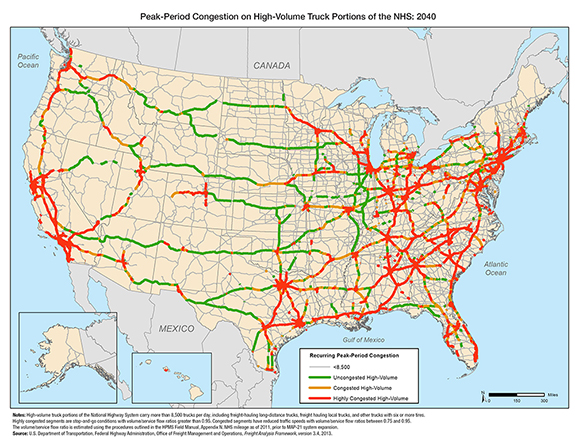Freight Facts and Figures 2013
Figure 3-19. Peak-Period Congestion on High-Volume Truck Portions of the National Highway System: 2040
Assuming no change in network capacity, the number of NHS miles with recurring congestion and a large number of trucks is forecast to increase significantly between 2011 and 2040. On highways carrying more than 8,500 trucks per day, recurring congestion will slow traffic on close to 7,400 miles and create stop-and-go conditions on an additional 22,000 miles.
Figure 3-19

Notes:
High-volume truck portions of the National Highway System carry more than 8,500 trucks per day, including freight-hauling long-distance trucks, freight-hauling local trucks, and other trucks with six or more tires. Highly congested segments are stop-and-go conditions with volume/service flow ratios greater than 0.95. Congested segments have reduced traffic speeds with volume/service flow ratios between 0.75 and 0.95. The volume/service flow ratio is estimated using the procedures outlined in the HPMS Field Manual, Appendix NHigh-volume truck portions of the National Highway System carry more than 8,500 trucks per day, including freight-hauling long-distance trucks, freight hauling local trucks, and other trucks with six or more tires. Highly congested segments are stop-and-go conditions with volume/service flow ratios greater than 0.95. Congested segments have reduced traffic speeds with volume/service flow ratios between 0.75 an 0.95. The volume/service flow ratio is estimated using the procedures outlined in the HPMS Field Manual, Appendix N. NHS mileage as of 2011, prior to MAP-21 system expansion.
Source:
U.S. Department of Transportation, Federal Highway Administration, Office of Highway Policy Information, Highway Performance Monitoring System; and Office of Freight Management and Operations, Freight Analysis Framework, version 3.4, 2013.
You may need the Adobe® Reader® to view the PDFs on this page.